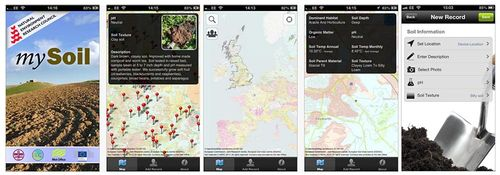OR/14/073 Data delivery
| Bell, P, Shelley, W, Smith, R S, and Tomas, R. 2014. Reusable tools for smartphone apps: innovative activities in the European geological sector. British Geological Survey, OR/14/073. |
 |
Based on the survey responses, the main purpose of 70% of the apps is to deliver data. When asked what types of data were provided, it was clear that a wide range of data and information across the geosciences sector is being supplied. The vast majority is spatial data and is being presented via a mapping interface.
Geological mapping information is most commonly provided as you would expect, but other data includes hydrography, protected sites, digital terrain models, land cover, land use, soils, industrial, agricultural, natural hazards, weather, habitats, minerals and tourism information. Many of these datasets relate to the INSPIRE Directive’s 34 Annex Themes. This result also suggests that a rich collection of integrated interdisciplinary apps being developed. 80% of the data provided via apps is also open, freely available data. Such information could be of interest across Europe or across borders as well as in the local area they were intended to serve, but no firm conclusions can be reached based on the survey responses.
We were also interested in whether a web service architecture was being used to provide data to apps. We discovered that an equal split existed between those using web services and those not. The mySoil app from the BGS (and partners Centre for Ecology & Hydrology (CEH), Met Office and the JRC) is an excellent example of the utilisation of web services to power a smartphone app (Figure 16), presenting parent material and soil property information from a range of content providers across Europe. Appendix 1: Case Study – Mobile app development techniques and strategies at the British Geological Survey (BGS) provides a case study of the BGS approach to mobile app development which gives further details about iGeology. provides a case study of the BGS approach to mobile app development and includes further details of the use of web services within the mySoil app.
As web services are prevalent in modern application design and the approach to sharing data promoted by INSPIRE, we might have expected the use of web services to be greater.

We wanted to know more about the role of INSPIRE and whether it had influenced/encouraged/facilitated the creation of apps that deliver data, contributing to the wider dissemination of spatial environmental information through the use of smartphone technology. Many of these questions were sparsely answered. We, therefore, do not have clear answers to questions asking whether web services were specifically developed for use in apps, whether such web services have been reused in other applications or whether app creators are incorporating third-party provided web services in their app. Such details could be followed-up through other studies involving qualitative research with relevant stakeholders.
Regarding INSPIRE, only 25% of the responders actively involved in developing apps stated that it had influenced or helped them make information available via apps and that it had influenced the design and architecture of their apps. As INSPIRE is still being implemented and not intended for app development as its key purpose, this figure should be expected. The other 75% of responders indicated that other frameworks/infrastructures/standards/best practice had a more significant influence on their development. They also, however, indicated that such frameworks could be readily applied outside of the geology community for use in other scientific domains. Some of the details provided for these alternative frameworks are potentially at odds with the low response regarding the direct influence of INSPIRE. In addition to RESTful web services, other alternative frameworks listed included Open Geospatial Consortium (OGC) web services, EuroGeoSource and OneGeology Europe which are in fact closely connected with INSPIRE and its principles.
 |